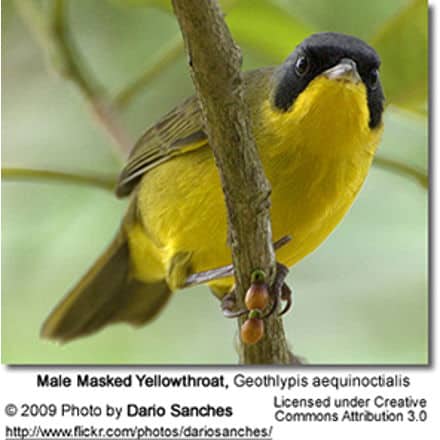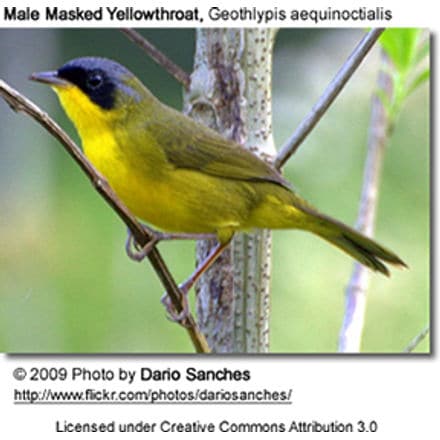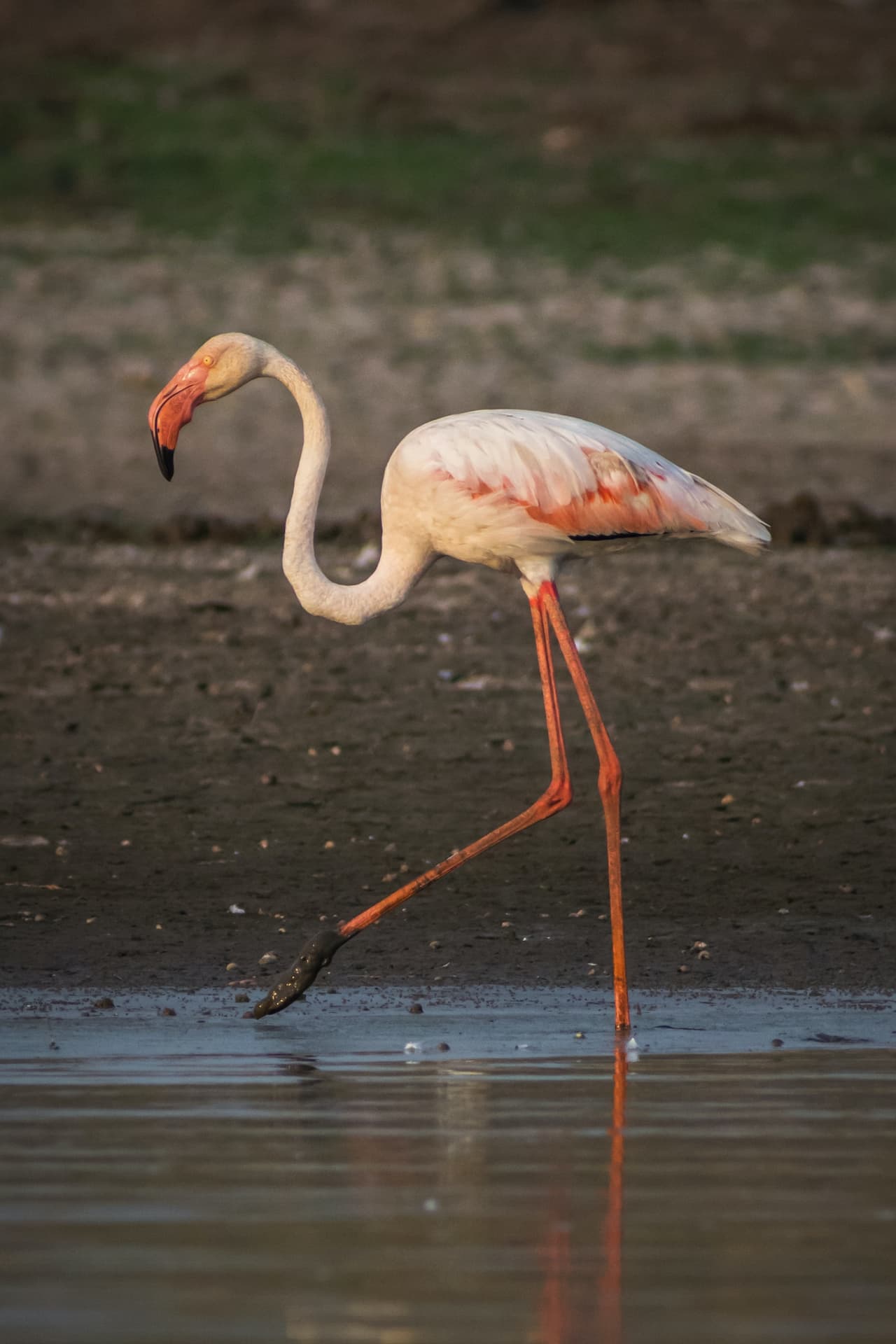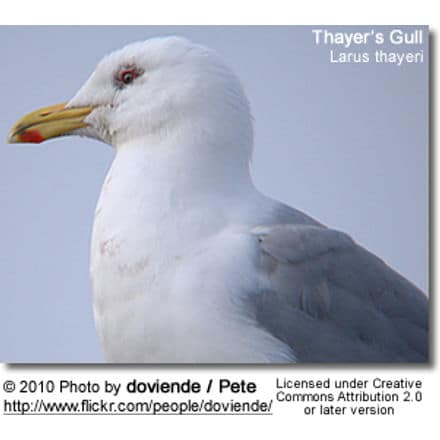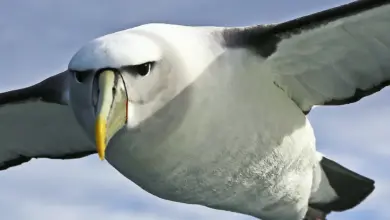Masked Yellowthroats
Masked Yellowthroats (Geothlypis aequinoctialis)
Yellowthroat Information … Yellowthroat Species Photo Gallery
The Masked Yellowthroats, Geothlypis aequinoctialis, is a New World warbler.
Masked Yellowthroats Range / Distribution
It has a number of separate resident breeding populations in Central and South America, some of which may be considered to form separate species.
This species may be spreading in Central America due to deforestation. It is often skulking, but may pop up occasionally, especially to sing.
The Masked Yellowthroat is usually seen in pairs, and does not associate with other species.
Masked Yellowthroats Description
The Masked Yellowthroat is 13.2 cm long and weighs 13g. It has yellow-green upperparts, bright yellow underparts, and a mainly black bill.
The adult male has a black facemask, bordered above with a grey band.
The female is similar, but lacks the black mask. She is slightly duller, and has grey sides to the face, with a yellowish eyering and a yellowish stripe from the bill to the eye.
Similar Species: This species is easily distinguished from wintering Common Yellowthroat by its uniform yellow underparts, whereas the North American bird has a white belly.
This species is easily distinguished from wintering Common Yellowthroat by its uniform yellow underparts, whereas the North American bird has a white belly.
There are significant racial variations in the male plumage (see Taxonomy).
Masked Yellowthroats Taxonomy
There are five subspecies of Masked Yellowthroat, differing in size, male head pattern and song. The Central American form is sometimes considered a separate species, and the two Pacific races together are also often treated as a species. Recent genetic evidence suggests that the southern South American subspecies may also merit specific status. The populations are as follows:
-
- The nominate race, G. a. aequinoctialis, described above, breeds from central Colombia, through northern
Venezuela, Trinidad, the Guianas, to the regions near the Amazon River in Brazil. The song is a warbled tee-chee-chee teecheweet teecheweet.
- The nominate race, G. a. aequinoctialis, described above, breeds from central Colombia, through northern
-
- G. (a). velata, the “Southern Yellowthroat”, breeds in central South America from south-eastern Peru and adjacent parts of Brazil, through Bolivia, Paraguay, Uruguay and southern Brazil, to central Argentina. It is slightly smaller than aequinoctialis, and the male has a narrower black mask, with a broader grey band which extends onto the nape and neck sides. The song is longer, faster and more warbled than that of the northern race.
-
- G. (a). auriculata and G. a. peruviana, the “Black-lored Yellowthroat”, breeds in western Ecuador and western Peru. The male has the black mask restricted to the area from the bill back to the eye and a narrow band on the forehead. The subspecies peruviana, which is found in the Marañón valley, is similar in size to aequinoctialis, but auriculata is
noticeably smaller. The song of is a cheerful wee wee wee weeyou weeyou.
- G. (a). auriculata and G. a. peruviana, the “Black-lored Yellowthroat”, breeds in western Ecuador and western Peru. The male has the black mask restricted to the area from the bill back to the eye and a narrow band on the forehead. The subspecies peruviana, which is found in the Marañón valley, is similar in size to aequinoctialis, but auriculata is
- G. (a). chiriquensis, the “Chiriqui Yellowthroat”, occurs in western Panama and Costa Rica. It is another small form, but the male has the broadest black mask of all the races, extending on to the forecrown. The song is similar to auriculata, but repeated many times, becoming faster, higher and weaker before a final flourish, and it may be given in flight.
It is likely that the range of this species was once continuous, perhaps in the cooler conditions of the last ice age, but the populations are now separated by the wet lowland forests of the Amazon basin and eastern Panama. The distinctive Chiriqui form in the highlands of Costa Rica and western Panama is further separated from its relatives to the east by the Andes Mountains.
Masked Yellowthroats Nesting / Breeding
The breeding habitat is marshes and other wet areas with dense low vegetation. The Masked Yellowthroat may also be found in other areas with dense shrub, but is less common in drier habitats. Two white eggs with reddish-brown markings are laid in a lined cup nest low in grass or rank vegetation.
Masked Yellowthroats Call / Vocalization
The call is a fast chattering, quite unlike that of other yellowthroat species, and a more typical sharp chip.
Masked Yellowthroats Feeding / Diet
It feeds on insects, including caterpillars, which are usually captured in dense vegetation.
References
- BirdLife International (2004). Geothlypis aequinoctialis. 2006 IUCN Red List of Threatened Species. IUCN 2006. Retrieved on 09 May 2006. Database entry includes justification for why this species is of least concern
- New World Warblers by Curson, Quinn and Beadle, ISBN 0-7136-3932-6
- Birds of Venezuela by Hilty, ISBN 0-7136-6418-5
- ffrench, Richard (1991). A Guide to the Birds of Trinidad and Tobago, 2nd edition, Comstock Publishing. ISBN 0-8014-9792-2.
- A guide to the birds of Costa Rica by Stiles and Skutch ISBN 0-8014-9600-4
Copyright: Wikipedia. This article is licensed under the GNU Free Documentation License. It uses material from Wikipedia.org … Additional information and photos added by Avianweb.
Please Note: The articles or images on this page are the sole property of the authors or photographers. Please contact them directly with respect to any copyright or licensing questions. Thank you.




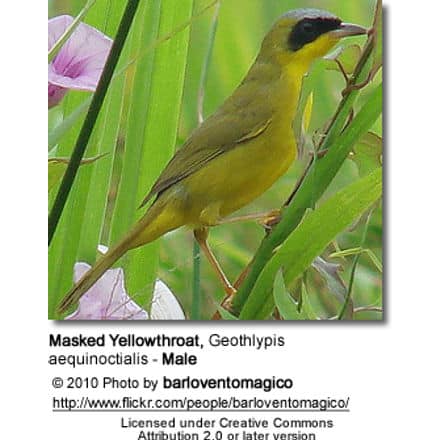 Venezuela, Trinidad, the Guianas, to the regions near the Amazon River in Brazil. The song is a warbled tee-chee-chee teecheweet teecheweet.
Venezuela, Trinidad, the Guianas, to the regions near the Amazon River in Brazil. The song is a warbled tee-chee-chee teecheweet teecheweet.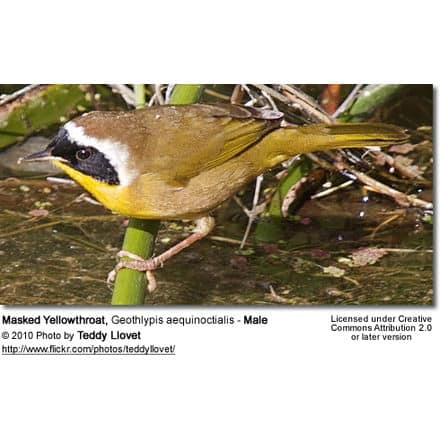 noticeably smaller. The song of is a cheerful wee wee wee weeyou weeyou.
noticeably smaller. The song of is a cheerful wee wee wee weeyou weeyou.